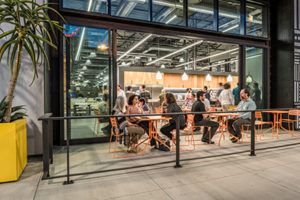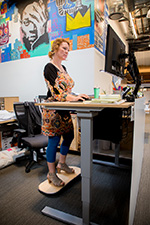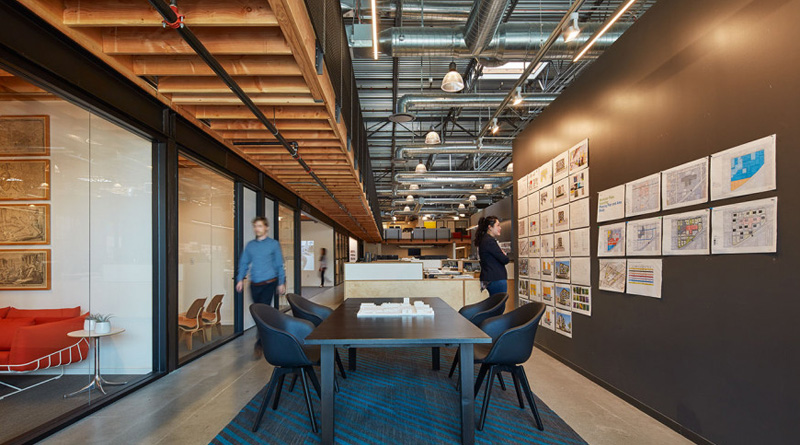5 Essential Design Trends for Every Creative Workplace
By Sara Hickman & Jonathan Lopez
Several decades ago, cubicle farms led creative workplace trends. Corporate America’s workforce was largely defined by the quantity of human capital spurring maximum personnel per square foot. With disregard to human health and wellness, the soulless cubicle farm model spread to become the norm worldwide.

While profitability is certainly a product of productivity, it also involves a sensitive balance of qualitative and quantitative characteristics. We are a byproduct of our physical and social environment. The workplace is an important, integral part of our lives since we spend 90 percent of our time indoors and 50 percent of time at the office. Scientific data allows us to better understand how our work environments impact our social, mental and physical health. A company’s culture defines a brand and sets the tone for how a work environment dynamically functions.
When our firm, Long Beach, Calif.-based Retail Deign Collaborative (RDC), opened the doors to our new creative workplace, we felt it was important to look beyond the essentials that characterize the modern office space. We used our new office as a meaningful case study on how to integrate impact on human health, wellbeing and productivity. As a result, our office achieved both LEED Platinum and WELL Gold certification as proof of our efforts.
We used our new headquarters as a functioning lab and case study space to ideate and test workplace strategies. With this process, we have identified five trends that impact the design of the workplace:
Warm-Up & Cool-Down
Some of the most thoughtful exchanges occur just prior to or post meetings. Consider that brilliant introvert on your team who remains silent in every meeting, but always seems to inspire you with a thoughtful idea shortly after in private. These informal interactions act as incubators for ideas elevating a team or project to the next level. It’s critical to have adaptable spaces that support a variety of interactions, formal to informal. Creating spaces to collaborate in a more casual, comfortable setting increases productivity by supporting workflow and decreases the need to schedule extraneous meetings.

Third Spaces
“Third spaces,” casual breakout areas both indoors and outdoors are becoming an increasingly important part of office design. These unique spaces support our natural need for variety of settings that engage our demanding high performance lifestyles. RDC has incorporated a variety of these “nooks.” Our community kitchen includes a 50-foot bar and café seating to complement the adjacent pedestrian street and to connect with both residents and visitors passing by along the Promenade. “Urban porches,” designed at the building’s entrance, orient our office’s primary gathering spaces to the street. These porches act as flexible spaces, serving as art galleries, pop-up shops and informal meeting hubs.
Adaptability & Community Integration
As the demand for creative office space grows, it’s important for developers to consider adaptability and to integrate one’s business into the overall community. Our move from a corporate tower to an urban street-level, adaptive reuse space — a former Nordstrom Rack — allowed the community to engage with us. This was a key initiative to have our space better align with our mission to rebuild and revitalize communities. Hosting community events and offering shared workspaces for nonprofits, our office is an integral part of this thriving downtown community hub.

Photo Credit (all): Retail Design Collaborative
Health & Wellness Driving Employee Satisfaction
Since The WELL Building Standard’s launch in 2013, more and more companies have prioritized supporting employees’ health and wellness. According to the International WELL Building Institute’s website and a Dodge Analytics study, 69 percent of building owners believe that healthy building features support employee job satisfaction. A big part of mental health stems from company culture. In addition to offering adjustable height desks; we offer amenities like FluidStance motion boards to promote standing and proper posture, which contributes to reducing chronic back pain.
Beyond the Open Office
We are seeing many companies use the allure of an open-layout office as an excuse to jam-pack employees into benching, common desks. Unfortunately, this can provide more opportunity for distractions and inefficiency. Successful office design uses a design process, programming, including pre- and post-occupancy surveys, to creatively integrate a company’s culture, vision and needs. This is particularly relevant as Generation Z enters the workforce. While they appreciate open and collaborative office culture, they also seek balance with their own sense of space. Huddle rooms and private spaces with full technical capabilities give employees access to quiet spaces.
Sara Hickman is sustainability director for Retail Design Collaborative, while Jonathan Lopez is associate principal and design director for the company.

